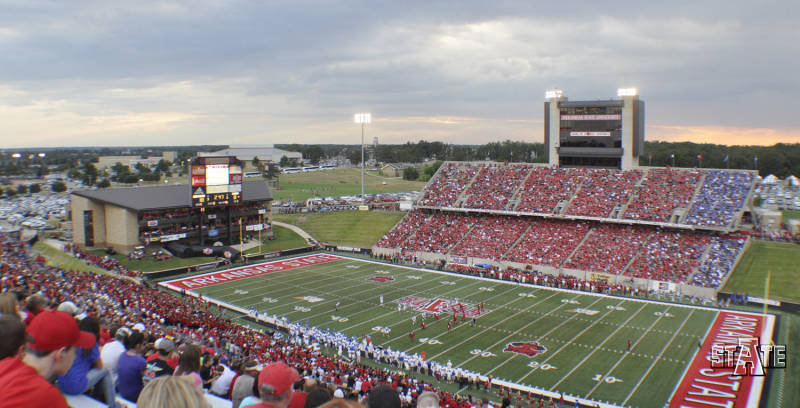-
Posts
2,703 -
Joined
-
Last visited
-
Days Won
10 -
Points
5,620 [ Donate ]
Everything posted by Arkstfan
-
Big East won't die, even if the more recent noise of MWC contacting at least one other Big East other than Boise and SDSU is true. I'd be surprised if Houston/SMU opted to go that direction even though a division of Houston, SMU, New Mexico, Air Force, Colorado State, Wyoming, USU would have some appeal. Assuming only Boise and SDSU bail the Big East still has UConn, Cincy, Temple, UCF, USF, ECU, Memphis, Tulane, SMU, Houston, and Navy. They can pick up one and they are OK with the likely targets being Buffalo, UMass, Charlotte, ODU, USM, Tulsa. There is some thought Navy might back out but the target list looks pretty much the same. Worst case for CUSA is lose two and is still at 12.
-
I thought ASU might be in the hunt for buster, but that was before we changed head coaches yet again. Great schedule for it and not losing that many starters.
-
The one with football
-
I'm not so sure. If they unbundle the rights so that you choose whether you are placing tier 1 or 2 rights or both into the pool the money won't be blockbuster but it will be OK, especially if people start making their own regional/local deals. If he can get Fresno, UNLV, BYU the west becomes SDSU, Fresno, UNLV, Boise, BYU, Houston, SMU and presumably Tulane. Not great but manageable.
-
From the sound of it, I'd say MSG is off the table for the Big East.
-
The rumors persist but I don't see anything imminent. The MWC isn't doing anything until they know that no one is coming back and they won't know that until another MWC defects to the Big East.
-
Actually what conferences have done in the past is say, you owe us X dollars in admission fee. We are going to withhold Y dollars per year from your distribution until X is paid. That's basically what the Big XII has done.
-
It's not about the money. It's not about power ratings. It's not about TV markets. It's not about prestige. What matters is being in a league where rivalries can develop. In the post-raid world there isn't going to be enough TV dollars to matter and history shows the top champ who would get the BCS bid is just as likely to come from a weak conference as a strong conference. It's about being able to compete and sell tickets.
-
LHN is unlikely to go belly-up. ESPN is on the hook for the full contract no matter whether it exists or not. The only loss to UT would be the equity share that they would get if it were to meet contracted targets.
-
That was Pac-12 round two (OU, OkSt, UT, TT). LHN wasn't a factor when the discussion was UT, TT, TAMU, OU, OKSt going to the Pac-10 with Colorado (and Utah not being invited. If you search the arcives of either FWS&T or DaMN there is a piece from some years back that details how when Arkansas left for the SEC that TAMU was ready to join the SEC and UT was wanting in the Big 10 before the politicians mobilized.
-
At one time, Tulsa had a waiting list for season tickets in basketball. They've not been at that level in some time to my knowledge but they are a school that loves hoops.
-
Per a source in Memphis, the Liberty is attempting to secure a Big XII selection to face the SEC there.
-
I skimmed GL's post. Anyone who puts up something longer than Kindle Single length posts needs to edit Huge conferences (ie. so big that teams never play all members) Are flawed from the get-go. I think any non-contract conference producing over $2 million per team is unlikely. A good friend put forth a good vision of what he would do if he were one of the presidents. Embrace regionalism, not localism. His explanation of the difference, regionalism is insuring that you have a conference where fans can make at least 2, ideally three road games per year and see all other teams within a reasonable amount of time. The regional leagues being schools that contribute to the health of the league. That being you add teams that you can check off as being in one of these categories. 1. Wins football games and sells tickets 2. Wins basketball games and can contend to be an at-large. 3. Brings academic prestige with a national academic reputation. 4. Provides a benefit such as being in a regional tourist destination so that opponents can effectively sell road trips as an alumni benefit. Localism under his definition is simply aligning with the closest schools. Localism isn't going to happen in most cases because you need someone to be outside the group. The examples he cited were Memphis and SMU. Memphis plays ASU pretty regularly in football but they don't want to be in the same conference they want to be able to not renew when ASU is strong (current deal expires in 2013) but have a non-conference that will be eager to play. The same applies to SMU and UNT.
-
Except they just busted the BCS with a team that lost their opening game of the season to Iowa.
-
What standard can you set that the current members can make? We all know what the attendance looks like at FIU and FAU. I hope we all know that reported budget figures tend to be bogus because some schools avoid state regulators by funneling some athletic functions like sports information and fund-raising through "academic" offices. Commitment is hard to assess. One school might produce $15 million a year by hitting students for $250 a semester. That indicates nothing but a willingness of the school to collect money via student loan debt and let someone else pay it off. FIU and FAU might look committed because of that debt shift but how many tickets do they sell, how many dollars do they get donated. I don't think you can create a meaningful standard and apply it to the current membership.
-
The WAC problem was two-fold Problem #1 was scheduling. They wanted their regional rivals because of ticket sales. Fans in Fort Collins cared more about playing Utah or New Mexico than Tulsa or San Jose. Plus the old WAC schools mostly traveled pretty well meaning that they sold a lot of the tickets your fans didn't sell. Problem #2. The MWC 8 understood that not every school has an identical television value. They walked away from the WAC16 and secured a TV deal that was nearly identical to the one they left behind. That money split 8 ways rather than 16 produced more value. If you look at the SEC. Without question, Ole Miss, Miss St, Vandy and Kentucky aren't bringing as much TV value as TAMU, Mizzou, LSU, Florida. But the number is so big and the history and traditional ties are so strong, no one is advocating booting those four. Arkansas struggles at times to sell their Little Rock game out, there is a reason they play Ole Miss and Miss State there. They eat up a good piece of the 8,000 ticket visitor allotment that the SEC mandates. Tennessee likes going to Vandy and UK because they can play a road game where their fans can negate home field most years. In a 20 team league it doesn't take long for someone to figure the numbers up and realize they can go to 9, 10, or 12 with the right schools and get basically the same money and split it fewer ways.
-
ESPN who isn't in the favor business, says a BYU football game is worth $800,000 to them. BYU has 60,000 fans per game and has fans across the country. Geography, religion, and academic politics are the only reason the Big XII and Pac-12 haven't invited them. They are the most BCS of the non-AQ. ESPN is looking to pay $4 million year for their TV rights. That gives ESPN up to 7 games to choose from and they are expected to take 5 games a year. Now let's consider the nBE First assume they end up with 14 teams and play an 8 game league schedule. That gives you 56 league games to telecast. Assuming each Big East school plays one non-conference road game that is another 42 games covered by the TV rights. To reach the 6.3 million figure quoted by Boise and San Diego State when they joined and assuming a value of $0 for basketball rights. A TV package covering every single Big East football game would have to have a value of $900,000 per game or be worth 12.5% more than the best five BYU games. If the value were equal to BYU then that would produce $5.6 million per school, still pretty darn good. But even ESPN liking BYU's large national fan base is only interested in four or five of the 7 games. So let's say that over the course of a 14 week season a large network wants three games per week, presumably one game on either Thursday or Friday and two Saturday games. A grand total of 42 games. Those games have the same value as BYU. That package is worth $2.4 million. Still better than the MWC and CUSA numbers but not by a very big margin. The question is are 42 nBE games worth as much apiece as a BYU game given the smaller fan bases?
-
Everyone is committed until they aren't. Right now everyone is sketching ideas and eventually one will catch the eye of at least 8 schools. They might go ahead and form the nBE just because its easier to continue that momentum but it won't likely last long.
-
UConn was I-AA and his predecessor won 11 games his last 2 years. Skip won 12 in the same span. Then 11 the next two years and then finally won 10 his final season going out in the second round of the playoffs. Went back to work for his dad after that. Did much better at ECU with one losing season, then 7, 8, 9, and 9 win seasons. Didn't crack the polls and went 1-3 in bowls. At USF had as many losing seasons in three years as Leavitt had in 13 years. He strikes me is the guy you hire when you fired your last coach, not the guy who you hire to keep your program a 9 game winner. Clearly a very good coach, just not a GREAT one. Tech had to be a hard sell though. Attendance hasn't been good in Ruston, their AD handed everyone a recruiting advantage against them by dodging ULM, and thinking long-term many coaches will wonder if the change in schedule will allow the success level to continue. Given the circumstances, Skip is a good hire but absent that anyone would question why a school that is coming off an 8 and 9 win season would hire him
-
I think it demonstrates how badly La.Tech has damaged their brand. Look at the peer group job openings at USM, WKU, ASU and how their hires are perceived.
-
The basketball schools understood what the football schools failed to understand. The league's financial base was basketball. They made more in NCAA units than bowl money despite being an AQ. Their TV deal assigned 2/3rds of their TV value to basketball. The league tournament in NYC is a huge highly profitable event matched in the hoops world only by the ACC Tournament and exceeded only by the NCAA Tournament. Expanding to drive football in an environment where football no longer had a guaranteed seat at the table was foolishness. Assigning 70% of TV revenue to football basically meant the 7 were subsidizing a football league that had no higher status as far as access than the MAC and Sun Belt. When the Big East had special status in football that had cachet that rubbed off on the hoop schools and it mattered, it no longer does.
-
The fascinating thing is that the basketball schools had to have voted for Tulane, then took a breath and said, Man that's a bad idea. UNT I think is in good shape, I'm not so sure everyone CUSA has added can say that.
-
The process for Temple is that they were admitted as an associate member and the league had membership standards that had to be met for associates. Each year the commissioner had to certify that associate members either met the standards or had a viable plan to meet said standards, the members then (by majority vote) had to agree to continue their membership. One year they meet and the Temple president says "Didn't meet and never will and nothing we do will change that." So the commissioner said pull the plug and the league voted to not continue their membership. When the Sun Belt formed, ULM was admitted for football on a two-year rolling basis. If no one did anything the deal automatically rolled over each year, but a majority vote would have stopped the renewal. Very different from being a full member.
-
Everyone is assuming the conference as economic engine is the model that works best. It is a 20 year old model dating back to the SEC title game in 1992 and the final death of the CFA TV deal after the 1995 season with each league cutting its own deal. The death of the SWC happened as the CFA deal died. The WAC grew from 10 to 16 to try to preserve viability as they cut their own TV deal without the CFA. The WAC16 failed to deliver and it spawned the MWC. The Big XII and formation of CUSA were direct responses to the CFA TV deal dying as the SEC pulled out. Everything that has happened since is reactionary to the conference becoming the economic engine. But what if the model changes? The dollars don't have to decrease for catastrophic effects, just how the dollars are collected. In a subscriber based world, does it make sense for Texas who would represent probably 1/3rd of all Big XII TV subscribers to take 1/10th? Does it make sense for Kansas to get 1/10th when Kansas might provide 1/15th of the subscribers? If a subscriber system emerges in a strong way, what reason is there for the conference to be an economic unit? The conference can go back to what it was first designed to be. A framework for scheduling, someone to handle assignment of officials, someone to keep stats and announce awards.
-
The most recent new episode Big Bang Theory drew as many viewers as the most watched college football game this year.




